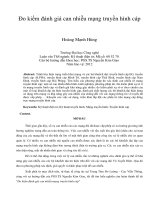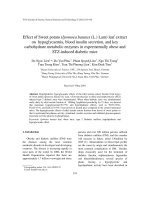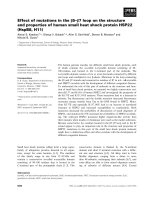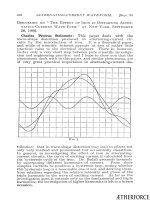Effect of supplementing bypass fat on milk yield, milk composition and chemical parameters of ghee in crossbred cows
Bạn đang xem bản rút gọn của tài liệu. Xem và tải ngay bản đầy đủ của tài liệu tại đây (231.66 KB, 6 trang )
Int.J.Curr.Microbiol.App.Sci (2018) 7(10): 2604-2609
International Journal of Current Microbiology and Applied Sciences
ISSN: 2319-7706 Volume 7 Number 10 (2018)
Journal homepage:
Original Research Article
/>
Effect of Supplementing Bypass Fat on Milk Yield, Milk Composition and
Chemical Parameters of Ghee in Crossbred Cows
N. Veena1*, M. Wadhwa2, H. Mehta1, A.K. Barui1, A.K. Puniya1,
J.S. Hundal2 and R.S. Grewal2
1
Department of Dairy Chemistry, College of Dairy Science and Technology, 2Department of
Animal Nutrition, College of Veterinary Science, Guru Angad Dev Veterinary and Animal
Sciences University, Ludhiana, 141004, Punjab, India
*Corresponding author
ABSTRACT
Keywords
Bypass fat, Crossbred
cows, Milk yield, Milk
composition, Chemical
parameters of ghee
Article Info
Accepted:
18 September 2018
Available Online:
10 October 2018
Five lactating crossbred cows were selected to investigate the effect of bypass fat
supplementation on milk yield, milk composition and chemical parameters of ghee. There
were no significant differences in milk yield, milk composition yield and fat proteincorrected milk yield, compared to base levels, recorded at the time of starting experimental
feeding. The bypass fat supplementation increased (P>0.05) the fat content but
significantly decreased the protein and SNF content in milk. Ghee prepared by direct
cream method was evaluated for its Reichert Miessl (RM), Polenske value (PV), Butyro
refractometer (BR) reading and Refractive index (RI). On feeding bypass fat supplement,
RM value in ghee increased from 26.65 to 28.31 but PV decreased from 1.17 to 0.83.
However, no significant difference in BR reading and RI on bypass fat supplementation.
Introduction
Many studies have been conducted on feed
supplementation with particular feeds either to
enhance milk production or modify the fatty
acid profile, especially to increase the fraction
of unsaturated fatty acids in milk fat. High
energy supplements such as fat and oils are
added to increase energy density of animal
diets, while protein sources of better amino
acid composition for milk synthesis are being
used in dairy animals diets (Tripathi, 2014). In
general, supplements of plant oils or oil seeds
rich in unsaturated fatty acids (C18:2 and C18:3)
reduce the proportion of short- and medium chain fatty acids (C6:0-C16:0) and increase the
proportion of C18:0. Calcium salts of longchain fatty acids has been shown to be
effective as ruminally inert fat supplements for
lactating cows and are often fed to enhance
energy density of ration and energy intake in
early lactation without compromising the
activity of rumen microflora (Tyagi et al.,
2009).
The ghee (clarified butterfat) is one of the
important sources of fat in the Indian diet. RM
value, polenske value (PV) and BR reading
2604
Int.J.Curr.Microbiol.App.Sci (2018) 7(10): 2604-2609
are considered as important quality parameters
of ghee under legal standards (Food Safety
Standard Authority of India). RM value is
substantially a measure of the lower chain
volatile water soluble fatty acids i.e butyric
acid (C4:0) contributes about 3/4th and caproic
acid (C6:0) about 1/4th to this value whereas
PV is a measure of lower chain volatile water
insoluble fatty acids i.e. caprylic acid (C8:0)
contributes about 1/4th and capric acid (C10:0)
about 3/4th to this value. Butyro-Refractometer
(BR) reading or refractive index which
measures the index of refraction between air
and the liquid fat, and vary with the nature of
the fat, is usually determined at 40oC. Many
previous research literatures showed the effect
of different feeds for dairy cows upon physical
and chemical parameters of milk fat produced.
For instance, Cranfield (1911) worked with
coconut cake and linseed cake and Cranfield
and Taylor (1915) with linseed cake and
hempseed cake. They showed that when cows
were removed from poor pasture to wellbalanced rations containing these products a
considerable rise in the RM, Kirschner, and
Polenske numbers and a fall in the index of
refraction occurred. Smith et al., (1916)
reported the feeding of cottonseed oil lowered
the saponification number and the soluble
fatty acids and increased the insoluble fatty
acids. In the present study, a feeding trial was
conducted to investigate the effect of bypass
fat supplementation on milk yield, milk
composition and chemical parameters of ghee
in crossbred cows.
Materials and Methods
Experimental design and diets
This study was conducted during March to
May months at Livestock Research Farm of
Guru Angad Dev Veterinary and Animal
Sciences University (GADVASU), Ludhiana,
Punjab. A farm-level feeding trial was
undertaken to evaluate the effect of
supplementing bypass fat on milk yield,
composition and chemical properties of ghee
in early lactating cross bred cows. A feeding
trial was conducted on five lactating crossbred
cows, yielding 7-8 kg milk per animal per day
for 7 weeks. Animals were selected based on
milk yield, fat per cent and stage of lactation.
Each animal was fed on a basal diet,
comprising 50 kg green fodder, 2 kg wheat
straw, 0.75 kg cotton seed and 8 kg
concentrate mixture per day as per
requirements and free access to drinking
water.
After recording the baseline information daily
for 3 weeks, animals were offered ad libitum
control diet supplemented with 200 g bypass
fat (calcium salts of rice bran oil fatty acids
was procured from Animal Nutrition
Department, GADVASU, Ludhiana) for 7
weeks, per animal per day.
Sample collection and chemical analysis
Feed intake of animals was measured weekly
and samples of feed were collected for
laboratory analysis. After being dried (80oC)
and ground to pass a 1 mm sieve, feed samples
were analyzed in duplicate for dry matter
content, total ash, nitrogen and ether extract
(AOAC, 1995) and acid detergent fibre
(ADF), acid detergent lignin (ADL), neutral
detergent fibre (NDF) and cellulose
(Robertson and Van Soest, 1981).
All cows were milked twice a day at 05:00
and 15:00 h. Milk yields were individually
recorded daily. Samples of milk (approx. two
liters) were drawn weekly from each animal
and were analyzed for fat, solids-not-fat (SNF)
and protein content by a MilkoScreen
(Indifoss Analytical Pvt. Ltd., Ahmedabad,
India). Cream was separated from the each of
the individual milk samples by centrifugal
method in the cream separator. Milk corrected
for its fat and protein content to a standard of
2605
Int.J.Curr.Microbiol.App.Sci (2018) 7(10): 2604-2609
4.0% fat and 3.3% protein. This is a standard
used for comparing milk with different fat and
protein contents. The yield of fat proteincorrected milk (FPCM) was also estimated.
Cream samples were then converted in to ghee
by direct cream method as described by De
(2005). The ghee samples were stored in
refrigerator (4oC) until for further analysis.
The ghee samples were analyzed for Reichert
Meissl (RM) and Polenske value (PV) as per
the standard procedure (IS, 1966).
Butyro refractometer (BR) reading and
refractive index (RI) of ghee was measured
using digital butyro refractometer (Atago Co
Ltd, Tokyo, Japan).
Statistical analysis
Results were expressed as overall mean±sd
values of different parameters before and after
supplementation of bypass fat to crossbred
cows. The data were analyzed by t-test using
the procedures described by SPSS (1996).
Significance was declared at P<0.05.
Results and Discussion
The chemical and nutrient compositions of
feeds used in the experiment are shown in
Table 1. The dry matter intake of animals was
17 kg/day/animal and the roughage to
concentrate ratio was observed to be 45.6 to
54.4.
On supplementation of bypass fat in the diet of
crossbred cows, average milk yield increased
(p>0.05) from 18.66 to 20.50 kg/d (Table 2),
confirming the earlier report of increase in
milk yield of crossbred cows in early lactation
(Erickson et al., 1992; Garg et al., 2008; Naik
et al., 2009; Wadhwa et al., 2012), however
significant difference was not observed. The
increase in milk production is mainly because
of improved energy status of the animals
especially in early lactation. However, other
researchers reported no improvement in milk
yields (Klusmeyer et al., 1991; Sklan et al.,
1992; Elliott et al., 1996; Lounglawan et al.,
2007) or milk fat contents (Atwal et al., 1990;
Garcia-Bojalil et al., 1998) from feeding
rumen-bypass fat.
The bypass fat supplementation decreased
(P<0.05) the protein and SNF content in milk
but no significant difference in milk fat
content. Some researchers reported that when
rumen bypass fat was supplemented to the diet
of dairy cows the reduction of fat and crude
protein contents (Erickson et al., 1992; Sklan
et al., 1992; Rodriguez et al., 1997) while
other researchers found the increase of milk
fat content (Klusmeyer et al., 1991; Elliott et
al., 1996).
A reduction in milk protein contents might be
a result of reducing microbial protein
production (Rodriguez et al., 1997) or dilution
of milk protein as higher milk volume
synthesized is not synchronized with uptake of
amino acids by the mammary gland (DePeters
and Cant, 1992). Further, dietary fat impairs
amino acids transport to mammary gland and
decreases milk protein synthesis by inducing
insulin resistance (Palmquist and Moser,
1981).
The total fat, protein and SNF yields were not
altered
by
bypass
supplementation.
Supplementation of bypass fat during early
lactation, resulted in higher (p>0.05) fat
protein-corrected milk yield in comparison to
control group, however, significant difference
was not observed. Sklan et al., (1989) reported
that fat corrected milk yield was increased
with
calcium
salts
of
fatty
acid
supplementation
despite
non-significant
changes in milk yield and fat contents.
2606
Int.J.Curr.Microbiol.App.Sci (2018) 7(10): 2604-2609
Table.1 Chemical composition of feed and fodder offered during trial period
Parameter
Chemical composition (% dry matter basis)
CP
20.27
EE
3.36
NDF
44.47
ADF
27.09
ADL
6.01
Cellulose
20.67
Ash
9.62
Results are expressed as Mean values (n=3).
CP = crude protein; EE = ether extract; NDF = neutral detergent fibre; ADF = acid detergent fibre; ADL = acid
detergent lignin
Table.2 Effect of supplementation of bypass fat on milk yield and its
Composition in crossbred cows
Parameter
Control
Experimental
p-value
Milk yield, kg/d
18.66±2.809a
20.50±2.37a
0.068
Fat, %
2.98±1.153a
3.24±0.503b
0.021
Protein, %
3.35±0.177b
2.90±0.294a
0.003
SNF, %
9.52±0.286b
8.85±0.376a
0.00
Fat yield, kg/d
0.56± 0.241a
0.66±0.126a
0.073
Protein yield, kg/d
0.62± 0.097a
0.60± 0.077a
0.412
SNF yield, kg/d
1.78±0.134a
1.82±0.145a
0.690
FPCM yield, kg
12.96±1.67a
14.76±1.85a
0.118
Results are expressed as Mean±SD with different superscripts in each row differ significantly at P<0.05; PSE,
Pooled standard error; SNF – solids not fat; FPCM – fat protein corrected milk
Table.3 Effect of supplementation of bypass fat on chemical parameters of ghee
Parameter
Control
Bypass fat
P-value
RM value
PV
26.65±1.67a
1.17±0.283b
28.31±2.39a
0.83±0.181a
0.110
0.002
BR
43.04±0.52a
43.65±0.79a
0.104
RI
1.454±0.001
a
1.455±0.001
a
0.106
Results are expressed as Mean±SD with different superscripts in each row differ significantly at P<0.05
2607
Int.J.Curr.Microbiol.App.Sci (2018) 7(10): 2604-2609
Table 3 represents the effect of bypass
supplementation on chemical parameters of
ghee in crossbred cows. On feeding bypass fat
supplement to crossbred cows, RM value
increased from 26.65 to 28.31 (P>0.05).
However, significant decrease (P<0.05) in PV
was observed in experimental group. Beaulieu
and Palmquist (1995) who observed an increase
in proportion of C16:0 to C18:0 fatty acids and
decrease in proportion of C8:0 to C14:0 fatty acids
while butyric acid (C4:0) and caproic (C6:0)
concentration were unaffected due to dietary fat
supplementation in the form of calcium salts of
palm oil fatty acids. Purushothaman et al.,
(2008) also found that supplemental dietary fat
had no significant effect on concentration of
butyric acid in milk fat. Supplementation of
calcium salts of long chain fatty acids in the diet
of lactating cows generally decreases the
proportions of short and medium chain
saturated fatty acids (C6:0 to C16:0) of milk fat
due to reduction in de novo fatty acid synthesis
in mammary gland and increase in proportions
of long chain fatty acids (C18:1, C18:2, C18:3) due
to increased uptake of preformed long chain
fatty acids from blood (Mishra et al., 2004).
The BR reading of the experimental and control
group was 43.65 and 43.04, respectively.
However, the dietary supplementation of bypass
fat did not show any significant impact on RI
and BR reading of ghee sample.
The study revealed that bypass fat
supplementation to lactating crossbred cows is
beneficial in terms of improvement in milk
yield and FPCM yield but significant decrease
in SNF and protein content in milk. Bypass
supplementation significantly decrease PV of
ghee, however, no such effect on RM value, BR
reading and RI of ghee.
Acknowledgement
Authors are thankful to the Punjab State
Cooperative Milk Producer’s Federation
Limited, Chandigarh for providing financial
assistance for carrying out this research work.
References
AOAC. 1995. Official Methods of Analysis. 7
edn. Association of Official Analytical
Chemists, Arlington, Virgina, USA.
Atwal, A.S., Hidiroglou, M., Kramer, J.K.G.,
and Binns, M.R. 1990. Effects of feeding
α–tocopherol and calcium salts of fatty
acids on vitamin E and fatty acid
composition of cow’s milk. J. Dairy Sci.
73(10): 2832-2841.
Beaulieu, A.D., and Palmquist, D.L. 1995.
Differential effects of high fat diets on
fatty acid compositions in milk of Jersey
and Holestein cows. J. Dairy Sci. 78(6):
1336-1344.
Cranfield, H.T. 1911. The effect of feeding
cocoanut cake and linseed cake on the
composition of butter-fat. Analyst 36:
445-449.
Cranfield, H.T., and Taylor, M.G.D. 1915. The
effect of feeding on the composition of
milk and butter: linseed cake and
hempseed cake. Analyst 40: 433-439.
De, S. 2005. Outlines of Dairy Technology.
Oxford Publishing Company, New Delhi.
DePeters, E.J. and Cant, J.P. 1992. Nutritional
factors
influencing
the
nitrogen
composition of bovine milk: a review. J.
Dairy Sci. 75(8): 2043-2070.
Elliott, J.P., Drackley, J.K., and Weigel, D.J.
1996. Digestability and effects of
hydrogenated palm fatty acid distillate in
lactating dairy cows. J. Dairy Sci. 79(6):
1031-1039.
Erickson, P.S., Murphy, M.R., and Clark, J.H.
1992. Supplementation of dairy cow diets
with calcium salts of long-chain fatty
acids and nicotinic acid in early lactation.
J. Dairy Sci. 75(1): 1078-1089.
Garcia-Bojalil, C.M., Staples, C.R., Risco,
C.A., Savio, J.D., and Thatcher, W.W.
1998. Protein degradability and calcium
salts of long-chain fatty acids in the diets
of lactating dairy cows: Productive
responses. J. Dairy Sci. 81(5): 1374-1384.
Garg, M.R., Sherasia, P.L., Bhanderi, B.M.,
Gulati, S.K., and Scott, T.W. 2008. Effect
of feeding bypass fat supplement on milk
2608
Int.J.Curr.Microbiol.App.Sci (2018) 7(10): 2604-2609
production and characteristics of butter
fat. Indian J. Dairy Sci. 61(1): 56-61.
IS. 1966. Methods of sampling and test for ghee
(butter fat) (3508: 1966). Bureau of
Indian Standards, Manak Bhavan, New
Delhi.
Klusmeyer, T.H., Lynch, G.L., Clark, J.H., and
Nelson, D.R. 1991. Effects of calcium
salts of fatty acids and proportion of
forage in diet on ruminal fermentation
and nutrient flow to the duodenum of
cows. J. Dairy Sci. 74(7): 2220-2232.
Lounglawan, P., Suksombat, W., and
Chullanandana, K. 2007. The effect of
ruminal bypass fat on milk yields and
milk composition of lactating dairy cow.
Suranaree J. Sci. Technol. 14(1): 109117.
Mishra, S., Thakur, S.S., and Raikwar, R. 2004.
Milk production and composition in
crossbred cows fed calcium salts of
mustard oil fatty acids. Indian J. An. Nutr.
21: 22-25.
Naik, P.K., Saijpaul, S., and Rani, N. 2009.
Lactation response of crossbred dairy
cows fed on indigenously prepared rumen
protected fat – a field trial. Indian J. An.
Sci. 79(10): 1045-1049.
Palmquist, D.L., and Moser, E.A. 1981. Dietary
fat effects on blood insulin, glucose
utilization and milk protein content of
lactating cows. J. Dairy Sci. 64(8): 16641670.
Purushothaman, S., Kumar, A., and Tiwari,
D.P. 2008. Effect of feeding calcium salts
of palm oil fatty acids on performance of
lactating
crossbred
cows.
AsianAustralian J. An. Sci. 21(3): 376-385.
Robertson, J.A., and Van Soest, P.J. 1981. The
detergent system of analysis and its
application on human food. In: The
Analysis of Dietary Fibre in Food (Eds.)
W.P.T. James and O. Theander. Marcel
Dekkar Inc., New York, Pp.123–158.
Rodriguez, L.A., Stallings, C.C., Herbein, J.H.,
and McGilliard, M.L. 1997. Effect of
degradability of dietary protein and fat on
ruminal, blood, and milk components of
Jersey and Holstein cows. J. Dairy Sci.
80(2): 353-363.
Sklan, D., Ashkenazi, R., Braun, A., Devorin,
A., and Tabori, K. 1992. Fatty acids,
calcium soaps of fatty acids, and
cottonseeds fed to high yielding cows. J.
Dairy Sci. 75(9): 2463-2472.
Sklan, D., Bogin, E., Avidar, Y., and Gur-Arie,
S. 1989. Feeding calcium soaps of fatty
acids to lactating cows: effect on
production, body condition and blood
lipids. J. Dairy Res. 56: 675-681.
Smith, F.H., Wells, C.A., and Ewing, P.V.
1916. The changes in composition of
butter fat produced by feeding cottonseed
oil. Bulletin (Georgia Experiment
Station), Experiment, Ga.
SPSS. 1996. Statistical Packages for Social
Sciences. Version 12.0, SPSS Inc.,
Linois, USA.
Tripathi, M.K. 2014. Effect of nutrition on
production, composition, fatty acids and
neutrceutical properties of milk. J. Adv.
Dairy Res. 2(2): 115.
Tyagi, N., Thakur, S.S., and Shelke, S.K. 2009.
Effect of feeding bypass fat supplement
on milk yield, its composition and
nutrient utilization in crossbred cows.
Indian J. An. Nutr. 26(1): 1-8.
Wadhwa, M., Grewal, R.S., Bakshi, M.P.S., and
Brar, P.S. 2012. Effect of supplementing
bypass fat on the performance of high
yielding crossbred cows. Indian J. An.
Sci. 82(2): 200-203.
How to cite this article:
Veena, N., M. Wadhwa, H. Mehta, A.K. Barui, A.K. Puniya, J.S. Hundal and Grewal, R.S. 2018.
Effect of Supplementing Bypass Fat on Milk Yield, Milk Composition and Chemical Parameters of
Ghee in Crossbred Cows. Int.J.Curr.Microbiol.App.Sci. 7(10): 2604-2609.
doi: />
2609









